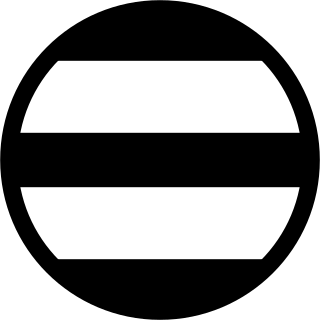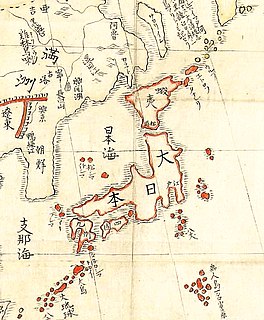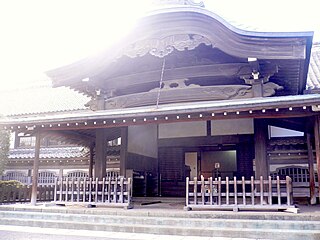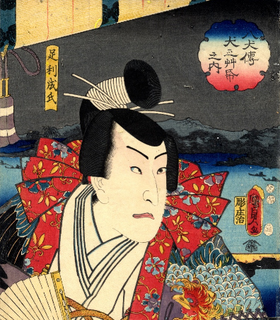
Ashikaga Yoshimasa was the 8th shōgun of the Ashikaga shogunate who reigned from 1449 to 1473 during the Muromachi period of Japan.

Ashikaga Yoshinori was the sixth shōgun of the Ashikaga shogunate who reigned from 1429 to 1441 during the Muromachi period of Japan. Yoshinori was the son of the third shōgun Ashikaga Yoshimitsu. His childhood name was Harutora (春寅).

Ashikaga Yoshimochi was the 4th shōgun of the Ashikaga shogunate who reigned from 1394 to 1423 during the Muromachi period of Japan. Yoshimochi was the son of the third shōgun Ashikaga Yoshimitsu.

The Nanboku-chō period, spanning from 1336 to 1392, was a period that occurred during the formative years of the Muromachi bakufu of Japanese history.

The Ashikaga clan was a prominent Japanese samurai clan which established the Muromachi shogunate and ruled Japan from roughly 1333 to 1573.

Ōei (応永) was a Japanese era name after Meitoku and before Shōchō. This period spanned the years from July 1394 through April 1428. Reigning emperors were Go-Komatsu-tennō (後小松天皇,) and Shōkō-tennō (称光天皇).
Kanrei (管領) or, more rarely, kanryō, was a high political post in feudal Japan; it is usually translated as shōgun's deputy. After 1349, there were actually two Kanrei, the Kyoto Kanrei and the Kantō Kanrei.

The Takeda Clan was a Japanese clan active from the late Heian period until the late 16th century. The clan was historically based in Kai Province in present-day Yamanashi Prefecture. The clan was known for their honorable actions under the rule of Takeda Shingen, one of the most famous rulers of the period.

The Uesugi clan was a Japanese samurai clan, descended from the Fujiwara clan and particularly notable for their power in the Muromachi and Sengoku periods.

This is the glossary of Japanese history including the major terms, titles and events the casual reader might find useful in understanding articles on the subject.

The 1545–1546 Siege of Kawagoe Castle was part of a failed attempt by the Uesugi clan to regain Kawagoe Castle from the Later Hōjō clan in the Sengoku period of Japan. Uesugi Tomosada of the Ogigayatsu branch of the Uesugi clan attacking Kawagoe castle, he was joined by his more powerful relative Uesugi Norimasa from Yamanouchi branch Uesugi clan, who held the post of Kantō Kanrei, the shōgun's deputy in the Kantō region by Ashikaga Haruuji, the Kantō kubō in Koga, and by a host of anti-Hōjō daimyō from the Kantō region.
Uesugi Zenshū, also known as Uesugi Ujinori, was the chief advisor to Ashikaga Mochiuji, an enemy of the Ashikaga shogunate in feudal Japan. When he was rebuked by Mochiuji in 1415, and forced to resign, Zenshū organized a rebellion.

Ashikaga Mochiuji was the Kamakura-fu's fourth Kantō kubō during the Sengoku period in Japan. During his long and troubled rule the relationship between the west and the east of the country reached an all-time low. Kamakura was finally attacked by shōgun Ashikaga Yoshinori and retaken by force. Mochiuji and his eldest son Yoshihisa killed themselves to escape capture.
The Kyōtoku incident was a long series of skirmishes and conflicts fought for control of the Kantō region of Japan in the 15th century. The conflict began in 1454 with the assassination of Uesugi Noritada by Kantō kubō Ashikaga Shigeuji. The Ashikaga, Uesugi, and other clans then leapt to battle, either defending or assaulting Shigeuji. The chaos ended in 1482, when a peace was negotiated.

Kantō kubō (関東公方) was a title equivalent to shōgun assumed by Ashikaga Motouji after his nomination to Kantō kanrei, or deputy shōgun for the Kamakura-fu, in 1349. Motouji transferred his original title to the Uesugi family, which had previously held the hereditary title of shitsuji (執事), and would thereafter provide the Kantō kanrei. The Ashikaga had been forced to move to Kyoto, abandoning Kamakura and the Kantō region, because of the continuing difficulties they had keeping the Emperor and the loyalists under control. Motouji had been sent by his father, shōgun Ashikaga Takauji, precisely because the latter understood the importance of controlling the Kantō region and wanted to have an Ashikaga ruler there, but the administration in Kamakura was from the beginning characterized by its rebelliousness. The shōgun's idea never really worked and actually backfired.

Ashikaga Motouji (足利基氏) (1340–1367) was a warrior of the Nanboku-chō period. The fourth son of shōgun Ashikaga Takauji, he was the first of a dynasty of five Kantō kubō, Kamakura-based representatives in the vital Kamakura-fu of Kyoto's Ashikaga regime. Meant to stabilize a volatile situation in the Kantō, a region where many warrior clans wanted the return of the shogunate from Kyoto back to Kamakura, the dynasty he started almost immediately developed the ambition to usurp the shogunate, becoming a serious headache for the central government. Motouji was the only kubō who always remained loyal to the Kyoto government. During the Kannō disturbance, a historical episode with serious repercussions on his life, he tried to reconcile his father with his uncle Ashikaga Tadayoshi and, after his father's demise, he collaborated with his elder brother, shōgun Ashikaga Yoshiakira, to stabilize the shogunate. He died still young during an epidemic.

Ashikaga Ujimitsu (足利氏満) (1359–1398) was a Nanboku-chō period warrior and the Kamakura-fu's second Kantō kubō, or Shōgun Deputy. Son of first Kantō Kubō Ashikaga Motouji, he succeeded his father in 1367 at the age of nine when this last suddenly died during an epidemic. It was during his reign that the Kanto kubō title became common enough to appear for the first time in writing. It is in fact contained in a 1382 entry of the Tsurugaoka Jishoan (鶴岡事書安). This title was in itself rebellious, because it was first adopted by Takauji himself and its use therefore implied equality with the shogun. In fact, sometimes the Kanto Kubō was called Kantō shōgun.

Ashikaga Shigeuji (足利成氏) was a Muromachi period warrior and the Kamakura-fu's fifth and last Kantō kubō. Fourth son of fourth Kubō Ashikaga Mochiuji, he succeeded his father only in 1449, a full decade after his death by seppuku. His childhood name was Eijuō-maru (永寿王丸). His rule was from its onset troubled by hostilities with the central government: he was finally deposed in 1455 by shōgun Ashikaga Yoshimasa, after which he escaped to Koga in Shimōsa Province, where he became known as Koga kubō. There, he ruled until his death in 1497.

The Kamakura-fu or Kantō-fu was a regional government installed in Kamakura, in today's Kanagawa Prefecture, by the Ashikaga shogunate which lasted from 1349 to 1455. It was headed by a dynasty of Ashikaga rulers called Kamakura Kubō. They were assisted by deputies called Kantō Kanrei traditionally chosen among the members of the Uesugi clan.

The Horigoe Palace site is an archaeological site containing the ruins of the Muromachi period residence of the Ashikaga clan in the Jike neighborhood of the city of Izunokuni, Shizuoka in the Tōkai region of Japan. The site was designated a National Historic Site of Japan in 1984, with the area under protection extended in 1987.The name is also sometimes transliterated as "Horigoshi Gosho".


















